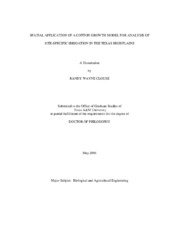| dc.contributor.advisor | Searcy, Stephen W. | |
| dc.creator | Clouse, Randy Wayne | |
| dc.date.accessioned | 2007-09-17T19:36:45Z | |
| dc.date.available | 2007-09-17T19:36:45Z | |
| dc.date.created | 2003-05 | |
| dc.date.issued | 2007-09-17 | |
| dc.identifier.uri | https://hdl.handle.net/1969.1/5887 | |
| dc.description.abstract | Limited water supplies for agriculture in the Texas High Plains will require new
irrigation technologies and techniques for agriculture to continue in this area. The
potential for using one such technology, site-specific irrigation, was evaluated using the
Cotton2k crop simulation model. This model and two other simulation models were
evaluated for their ability to track water movement and usage over three growing
seasons. The models were tested for sites in Lubbock and Hale County, Texas.
Cotton2k performed well compared to the other two models on tests of cumulative
evapotranspiration and applied water yield relations and equal to the other models for
tracking soil water profiles.
A global optimization method, simulated annealing, was tested for its ability to
spatially calibrate soil water parameters of Cotton2k. The algorithm found multiple
parameter sets for the same objective function results. This result runs contrary to
expectations for the simulated annealing algorithm, but is possibly from the relationship
between available water capacity and crop yield. The annealing algorithm was applied to each sampling point at the Hale County site and improved yield predictions for 32 of
33 points as compared to simulations made with soil textural information alone.
The spatially calibrated model was used with historic weather from five seasons to
evaluate a site-specific strategy where water was shifted from lower to higher yielding
areas of fields. Two irrigation strategies, one with irrigations weekly and one with
irrigations applied when 30% of available water was depleted, were tested. With sitespecific
management, the weekly interval strategy produced higher yields for two of
three water levels, as compared to uniform management. With the soil moisture
depletion strategy, site-specific management produced lower yields than uniform
management for all three water levels examined. Yield improvement and water savings
were also demonstrated for implementing site-specific irrigation when non-producing
portions of fields were previously being watered. | en |
| dc.format.extent | 1163356 bytes | en |
| dc.format.medium | electronic | en |
| dc.format.mimetype | application/pdf | |
| dc.language.iso | en_US | |
| dc.publisher | Texas A&M University | |
| dc.subject | crop model | en |
| dc.subject | global optimization | en |
| dc.subject | deficit irrigation | en |
| dc.subject | cotton | en |
| dc.title | Spatial application of a cotton growth model for analysis of site-specific irrigation in the Texas High Plains | en |
| dc.type | Book | en |
| dc.type | Thesis | en |
| thesis.degree.department | Biological and Agricultural Engineering | en |
| thesis.degree.discipline | Biological and Agricutural Engineering | en |
| thesis.degree.grantor | Texas A&M University | en |
| thesis.degree.name | Doctor of Philosophy | en |
| thesis.degree.level | Doctoral | en |
| dc.contributor.committeeMember | Cothren, J. Tom | |
| dc.contributor.committeeMember | Gilley, James R. | |
| dc.contributor.committeeMember | Munster, Clyde L. | |
| dc.type.genre | Electronic Dissertation | en |
| dc.type.material | text | en |
| dc.format.digitalOrigin | born digital | en |


